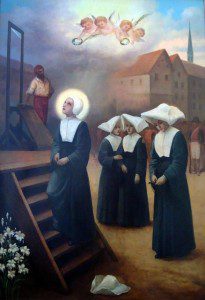
There were four Sisters who remained behind to work in the House of Charity during the French Revolution. They paid with their lives. They represent an earlier version of a story celebrated in the powerful film “Of Gods and Men” and the 7 Trappist monks who stayed behind in the ministry to the Moslems in Tibhirine, Algeria in 1996
Sisters Marie-Madeleine Fontaine, Marie-Françoise Lanel, Thérèse Fantou, Jeanne Gérard from the House of Charity in Arras
- Guillotined in Cambrai on 26 June 1794
- Beatified – 13 June 1920
- Feast day – 26 June
From the Daughters of Charity International website….The House of Charity in Arras was a beehive of activity. Seven Sisters cared for the sick, visited poor families and educated young children. The service was very well appreciated by the population.
Like everywhere, the Revolution questioned each one’s fidelity to Jesus Christ and to the Church. Quickly, Sister Coutacheaux decided to return to her family. The superior was worried about the two youngest Sisters. What fate did the revolutionaries have for them? She invited them to find refuge in Belgium. Sister Rose Michau and Sister Jeanne Fabre did not want to leave, but once the Terror came to Arras they followed the advice and went into exile. They rejoined the Company of the Daughters of Charity when it was reestablished. At the end of 1793 there were four Sisters, then, who remained working in the House of Charity.
Sister Marie Madeleine Fontaine, originally from Etrapigny (Eure), entered the Company in 1748 at the age of 25. As Superior of the community, her wisdom and competence were greatly appreciated. Sister Marie Françoise Lanel was born in 1745 in Eu (Seine Maritime). She entered the Daughters of Charity at the age of 19. Sister Thérèse Fantou was born in Miniac Morvan (Ille et Vilaine) in 1747. She became a Daughter of Charity at the age of 24. Sister Jeanne Gérardest was born in Cumières (Meuse) in 1752 and entered the Company of the Daughters of Charity in 1776.
The arrival in Arras of a new District leader, Joseph Lebon, brought a climate of violence and fear to the city. The House of Charity became the “House of Humanity” for which a new director was installed who surveyed the activities of the Sisters. The humiliations intensified and the false testimonies multiplied. On February 14 1794 the Sisters were arrested and taken to Saint-Vaast Abbey. The Sisters brought compassion to the prisoners who were distraught about their future. The Sisters underwent their first interrogation on the 4th of April. They again refused to take the oath since it was against their conscience.
Then, suddenly, on the night of June 25, the order was given to quickly transfer these four Sisters of Charity to Cambrai. The cart left at one in the morning and arrived in Cambrai at eight thirty. The Sisters were locked in the chapel of the old Seminary. In this place of prayer they meditated.
Then came a new court appearance and immediate condemnation to death. Waiting for the cart to take them to the guillotine the Sisters prayed their chapelet. The guards took their “good luck charms,” and, not knowing what to do, put them on their heads like a crown. Thus it was that they went through the city, singing the Ave Maris Stella. At the foot of the scaffold Sister Marie-Madeleine Fontaine repeated the prediction already made to those condemned, “We are the last victims.” That extraordinary prediction came true. The fall of Robespierre on July 27 1794 marked the end of the Revolution of Terror.
Visit the Vincentian Encyclopedia for more details.
Tags: Arras, Daughters of Charity, martyrs
